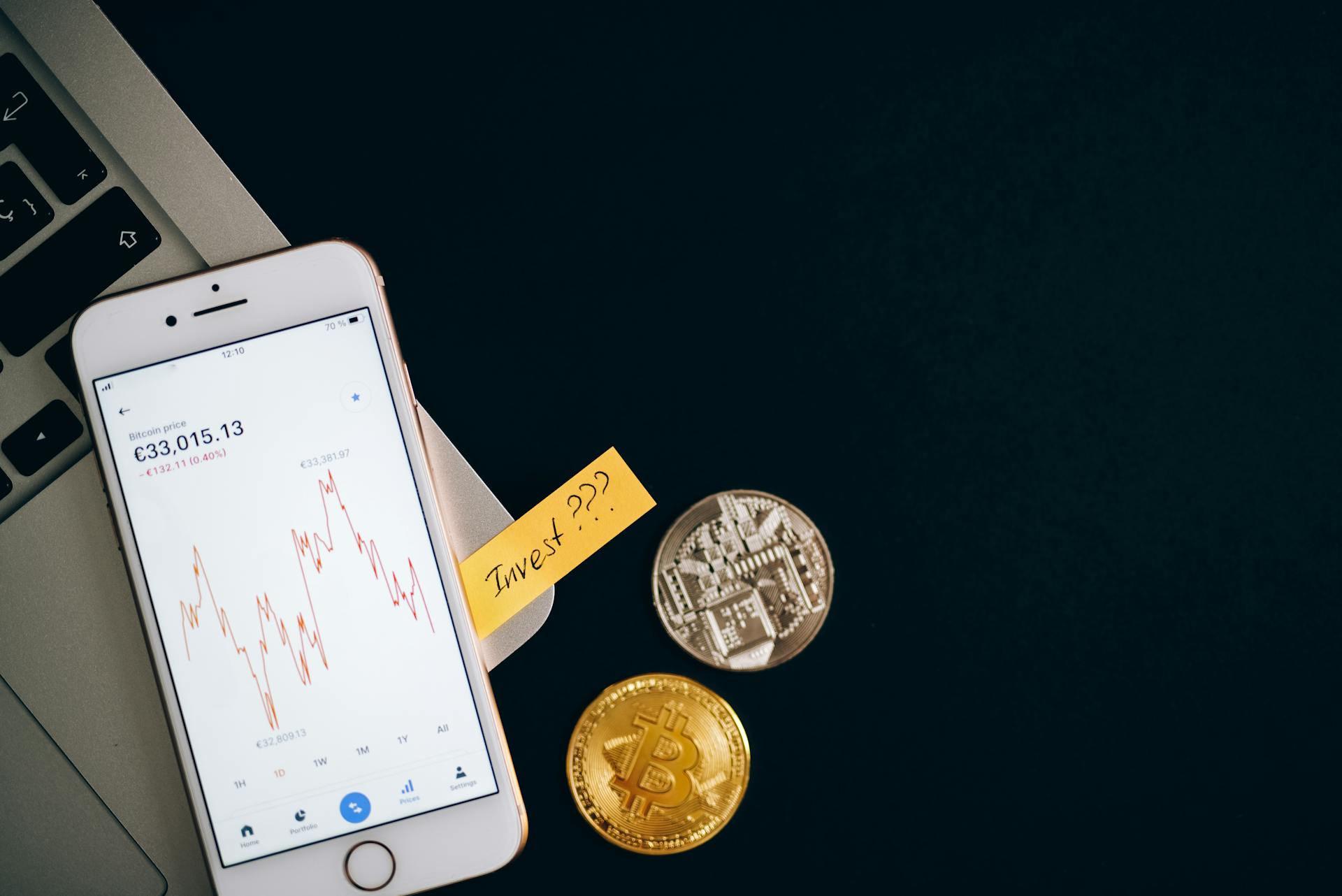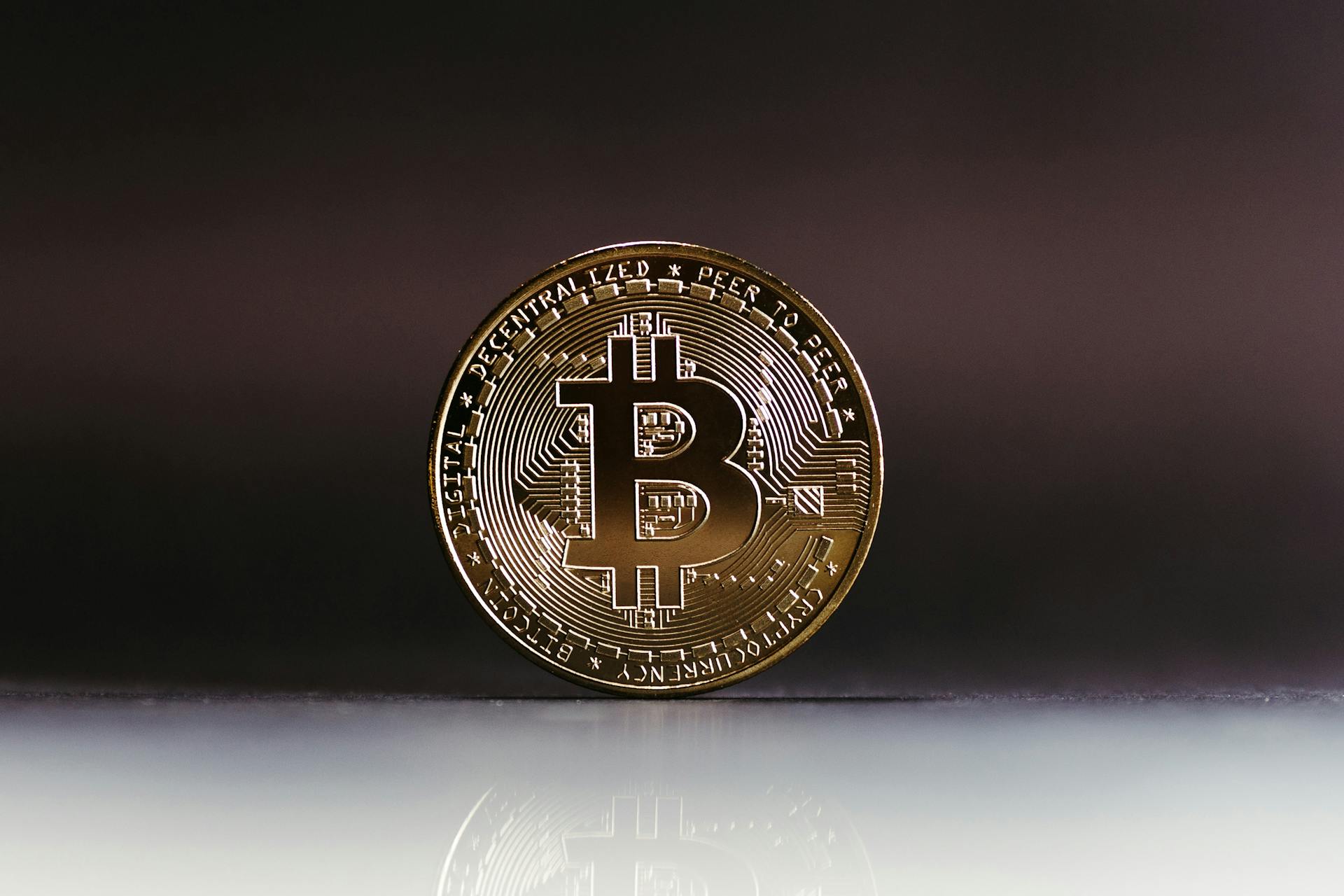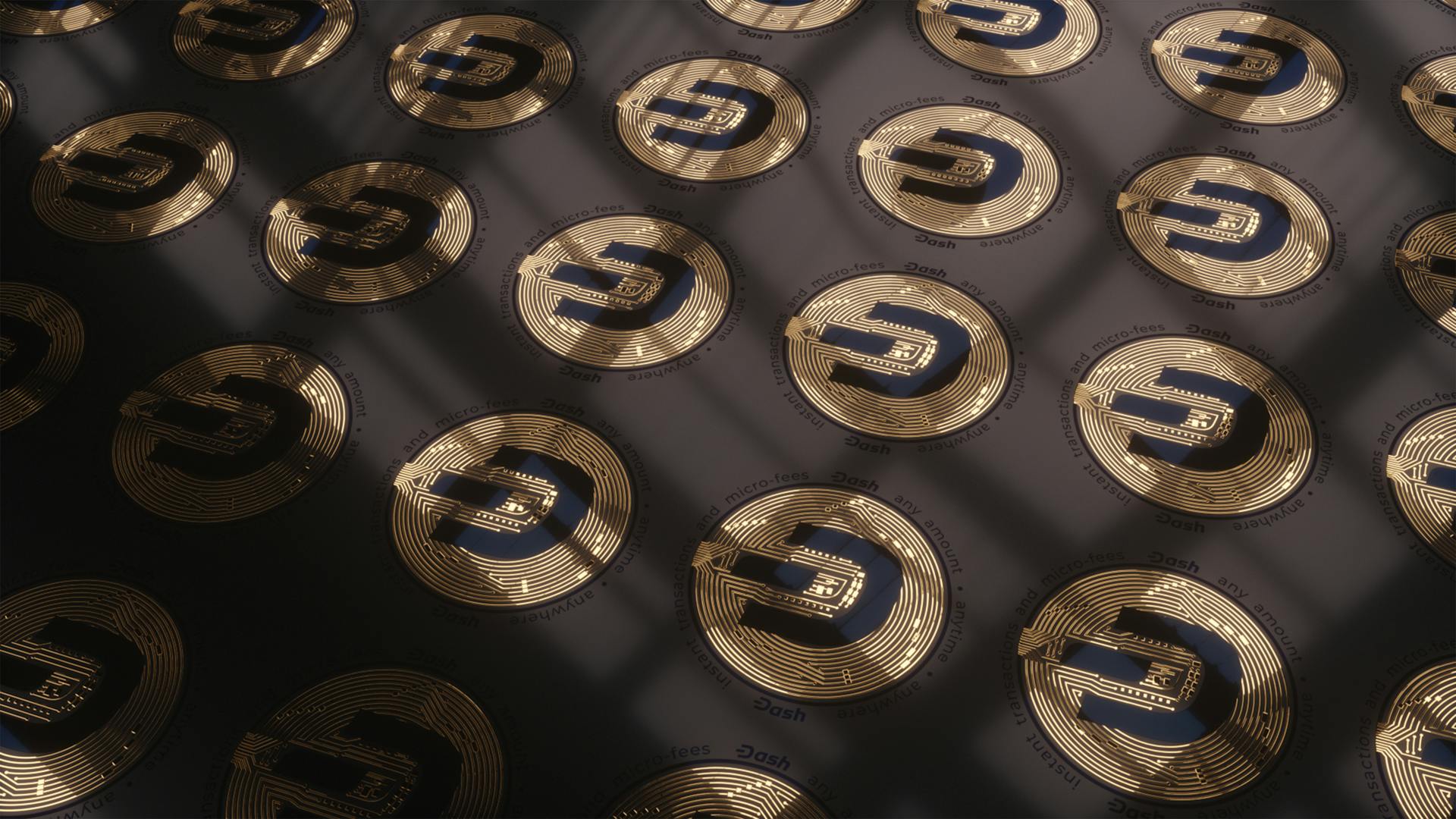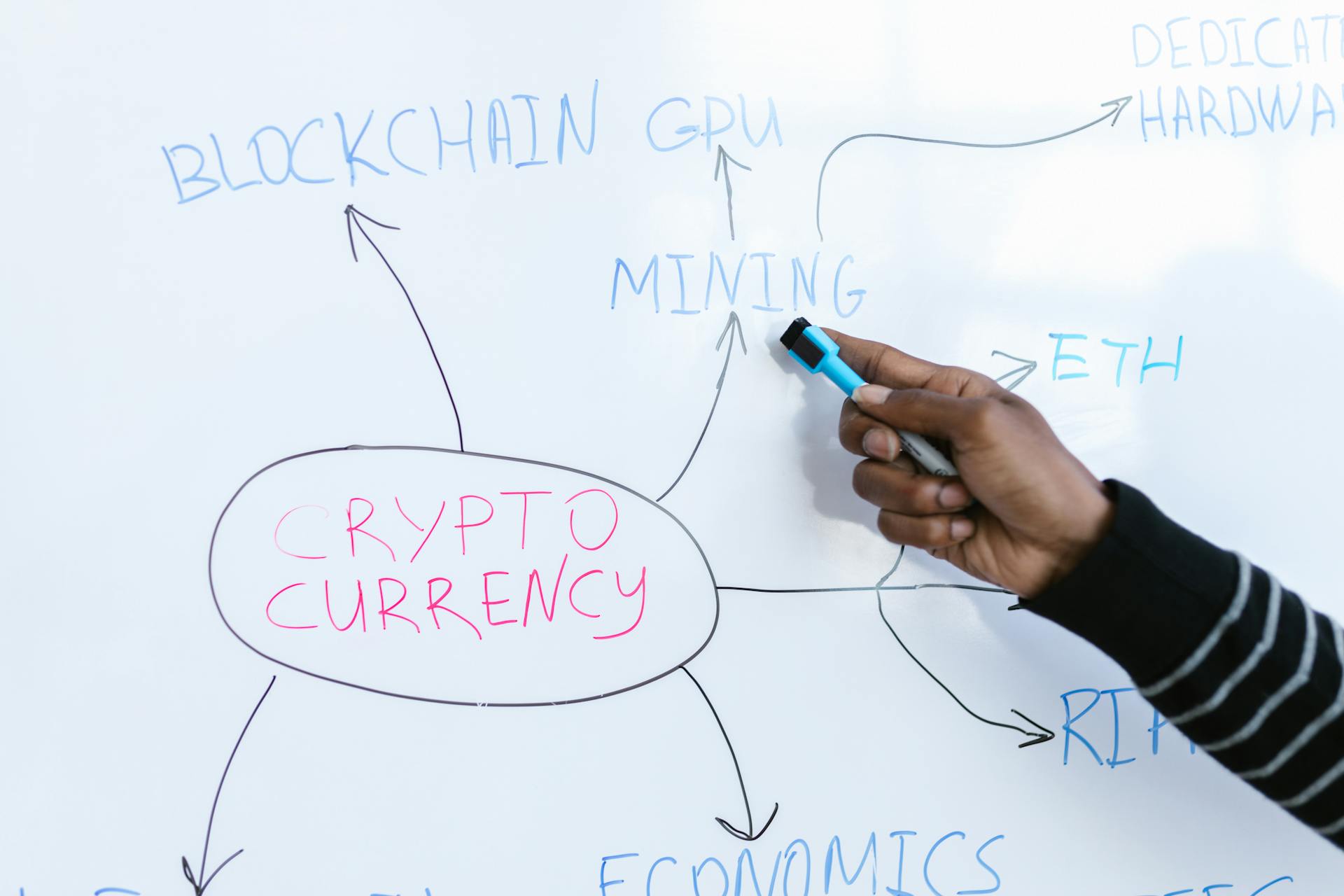
Stablecoins are a type of cryptocurrency designed to minimize price volatility, typically pegged to a stable asset like the US dollar.
Their purpose is to provide a more stable store of value and medium of exchange, especially for those who want to avoid the price swings of other cryptocurrencies.
This is achieved by maintaining a fixed exchange rate with the underlying asset, which is usually a fiat currency or a commodity.
By doing so, stablecoins can offer a more reliable and predictable alternative to traditional cryptocurrencies.
Worth a look: Initial Exchange Offering
What Are Stablecoins?
Stablecoins are designed to provide a more stable store of value compared to other cryptocurrencies. They aim to minimize price fluctuations, making them a more reliable option for everyday transactions.
Stablecoins are not bitcoins, nor are they intended to be a replacement for them. Instead, they offer an alternative to the high volatility of popular cryptocurrencies.
Stablecoins can be pegged to a specific currency, such as the US dollar, to maintain a stable value. This is one way they achieve their goal of providing a more stable store of value.
A unique perspective: Bitcoin History Chart
Types of Stablecoins
There are several types of stablecoins, and understanding the differences between them is crucial for making informed investment decisions.
Most stablecoins fall into three categories: fiat-collateralized, crypto-collateralized, and commodity-collateralized.
Fiat-collateralized stablecoins maintain a reserve of a fiat currency, such as the US dollar, as collateral, assuring the stablecoin's value. Tether (USDT) and TrueUSD (TUSD) are popular examples, backed by US dollar reserves and denominated at parity to the dollar.
Crypto-collateralized stablecoins, on the other hand, are backed by other cryptocurrencies. MakerDAO's Dai (DAI) stablecoin, for instance, is pegged to the US dollar but is backed by Ethereum (ETH) and other cryptocurrencies worth about 155% of the DAI stablecoin in circulation.
Commodity-collateralized stablecoins maintain reserves in non-blockchain assets, such as gold or commodities. Digix Gold (DGX) and Pax Gold (PAXG) are examples of commodity-collateralized stablecoins.
Decentralized stablecoins employ an overcollateralized design, requiring a blockchain price oracle to help trigger liquidations and ensure protocol solvency. LUSD is an example of a decentralized stablecoin that uses Chainlink Price Feeds to provide accurate price data.
Algorithmic stablecoins, however, may or may not hold reserve assets. Their primary distinction is the strategy of keeping the stablecoin's value stable by controlling its supply through an algorithm.
Consider reading: Ripple Launches Stablecoin Rlusd Pegged to U.s. Dollar
How Stablecoins Work
Stablecoins are designed to offer stability while benefiting from blockchain technology. They're often pegged to a fiat currency, like the U.S. dollar, which means their value is fixed at a certain rate.
Some popular stablecoins include Tether, USD Coin, Dai, First Digital USD, USDD, Ethnea USDe, TrueUSD, and Pax Gold. These coins are designed to maintain a stable value, unlike cryptocurrencies which can be highly volatile.
Stablecoins work by being pegged to an external reference, usually a fiat currency like the U.S. dollar. This allows them to be used as a medium of exchange, making them more useful than volatile cryptocurrencies.
To ensure stability, stablecoin creators hold onto reserves of other currencies or assets, a process known as collateralization. For example, a stablecoin issuer may promise to hold $1 in a bank account for each of the cryptocurrency coins it creates.
A stablecoin's pegged value is maintained through various economic mechanisms, including the ability to redeem tokens for fiat money, collateralized debt positions, arbitrage, and elastic supply. These mechanisms help to maintain the stablecoin's price stability.
Readers also liked: Fiat Backed Stablecoin List
Here are some common mechanisms used to maintain stability:
- Redemption: Coin holders can exchange their stablecoins for fiat money.
- Collateralized debt positions: Stablecoins are backed by collateral, such as fiat currencies or other assets.
- Arbitrage: Traders buy and sell stablecoins across different markets to maintain price stability.
- Elastic supply: The supply of stablecoins can be adjusted to maintain price stability.
Stablecoins can also be pegged to commodities like gold, or use algorithmic formulas to control supply. This helps to maintain their stability and value.
Benefits
Stablecoins offer several benefits, including enhancement of anti-money laundering efforts, operational resilience, customer data protection, financial inclusion, tax compliance, and cybersecurity.
They can also provide a stable store of value, reducing the risk of price fluctuations that can occur with other cryptocurrencies.
Stablecoins can be used as a non-custodial savings account, allowing users to store personal savings without the need for intermediaries.
In fact, stablecoins are commonly used as collateral in DeFi to generate returns and engage in yield farming strategies.
Their stability makes them a functional currency within a crypto brokerage, allowing traders to convert cryptocurrencies like Bitcoin into stablecoins like Tether.
Stablecoins are available 24/7, making them more accessible than cash obtained through the banking system.
Take a look at this: Paypal Has Used Its Stablecoin Pyusd in a Business Transaction.
They can also be used with smart contracts, which are a kind of electronic contract that is automatically executed when its terms are fulfilled.
Stablecoins have a market cap of over $100 billion, indicating that users around the world desire their stability.
By leveraging stablecoins, users can build an on-chain savings account, protect against market volatility, and earn yield.
Stablecoins can be used to send money across the globe, making them a valuable tool for international transactions.
Their stability also makes them a medium of exchange, allowing users to buy and sell goods and services without worrying about price fluctuations.
A unique perspective: Top Stablecoins
Risks and Concerns
Stablecoins may seem like a safe bet due to their peg to a traditional currency, but there are risks to consider.
One major risk is de-pegging, where the stablecoin's value deviates from its peg. This can cause volatility and is a risk even for algorithmic stablecoins that use complex algorithms to maintain their peg.
Security risks are also a concern, as smart contracts used for some stablecoins can be vulnerable to hacks or exploits.
Counterparty risk is another issue, as the stability of a stablecoin depends on the trustworthiness of the parties involved, including the bank holding the reserves and the organization issuing the stablecoin.
The reserve backing a stablecoin is the last line of defense in maintaining its value, but if it's not sufficient, the stablecoin can lose its peg and suffer a run.
Here are some potential risks to be aware of when considering stablecoins:
- Security: Smart contracts can be vulnerable to hacks or exploits.
- Counterparty risk: The stability of a stablecoin depends on the trustworthiness of the parties involved.
- Reserve risk: The reserve backing a stablecoin must be sufficient to maintain its value.
- Lack of confidence: A stablecoin can lose its peg if traders lose confidence in its ability to maintain the peg.
Risks and Criticisms
Stablecoins are not as risk-free as they seem. In fact, research has shown that the creation of unbacked USDT was attributed to the rise in Bitcoin's price in 2017.
There are several risks associated with stablecoins, including security risks, counterparty risk, and reserve risk. These risks can lead to de-pegging, where the stablecoin's value falls below its pegged value.
Algorithmic stablecoins, for example, use an algorithm to maintain their peg, but an error in the model or an unexpected economic event can disrupt this process. This can cause volatility in the stablecoin's value.
One of the primary risks of stablecoins is that they may not be fully backed by reserves. In an ideal situation, the issuer of the stablecoin has enough reserves to fully support the stablecoin, but any less than 100% and risk is introduced.
Counterparty risk is another concern, where the stability of the stablecoin depends on the stability of the parties involved in the transaction, such as the bank holding the reserves and the organization issuing the stablecoin.
To mitigate these risks, it's essential to have proper reserves in place. However, even with proper reserves, there is still a risk of de-pegging, as seen with the algorithmic stablecoin TerraUSD in May 2022.
A lack of proper reserves can lead to a loss of confidence in the stablecoin, causing its value to plummet. This is why an independent audit is crucial to ensure that the stablecoin is backed by the necessary assets.
Curious to learn more? Check out: Algorithmic Stablecoins
Here are some of the risks associated with stablecoins:
- Security risk: Smart contracts used for some stablecoins can be vulnerable to hacks or exploits.
- Counterparty risk: The stability of the stablecoin depends on the stability of the parties involved in the transaction.
- Reserve risk: The stablecoin may not be fully backed by reserves, leading to a loss of confidence and de-pegging.
- Lack of confidence: If the stablecoin is not sufficiently backed by hard assets, it can suffer a run and lose its peg against the target currency.
The Bottom Line
Stablecoins have become a hot topic in the cryptocurrency world, with many jurisdictions starting to regulate them due to past instabilities and losses.
The intent behind stablecoins is to create a crypto asset with lower price volatility, making them better for use in transactions.
Regulators are taking a closer look at stablecoins, with the Securities and Exchange Commission releasing a report on stablecoins and the International Organization of Securities Commissions applying principles for financial market infrastructures to stablecoin arrangements.
Stablecoins have experienced instabilities and losses, with TerraUSD stablecoin plunging as the crypto market awaited rescue.
Some stablecoins are becoming regulated, with the European Parliament passing a regulation on markets in crypto-assets in 2023.
The President's Working Group Report on Stablecoins highlights the risks associated with stablecoins, including the potential for instability and loss.
Regulators are working to establish clear guidelines for stablecoins, with the Lummis-Gillibrand Payment Stablecoin Act aiming to provide a framework for the use of stablecoins in payments.
Take a look at this: Decentralized Finance Market
Regulation and Stability
Regulators are paying close attention to stablecoins, with the International Organization of Securities Commissions proposing rules for systemically important stablecoins.
The proposed rules focus on stablecoins that could disrupt payment and settlement transactions, highlighting the potential impact of stablecoins on the broader financial system.
In the U.S., politicians are calling for tighter regulation of stablecoins, with Senator Cynthia Lummis advocating for regular audits of stablecoin issuers and others backing bank-like regulations for the sector.
The Markets in Crypto Assets Regulation in Europe bans algorithmic stablecoins and requires all other stablecoins to have assets held in custody by a third party, with a 1:1 ratio of assets to coins.
Maintaining price stability in stablecoins requires active management, such as adjusting collateral or using algorithmic adjustments to change the supply of the stablecoin.
Smart contracts can facilitate these stability-driven moves by self-executing on blockchain technology.
Regulatory uncertainty remains a challenge for stablecoins, with government agencies still figuring out how to regulate them and taking action against organizations that may have misrepresented their reserve holdings.
Consider reading: Stablecoin Regulation
Stablecoin Examples and Rankings
Tether (USDT) is the largest stablecoin by market capitalization, with a market value of $116 billion. It's pegged to the U.S. dollar at a 1:1 ratio and backed by reserves.
USDC is another popular stablecoin, issued by Circle and backed by one dollar or an asset with equivalent fair value. It's redeemable for 1 USD, ensuring a 1:1 peg with the U.S. dollar.
MakerDAO's decentralized stablecoin, DAI, maintains its peg through a smart contract that adjusts interest rates to encourage borrowers to pay back their debt or take out more stablecoin loans. This approach helps keep the price of DAI stable.
DAI has a market value of $5 billion, making it one of the most popular stablecoins. It's a great example of a decentralized stablecoin that's maintained its peg through a clever use of smart contracts.
The most popular stablecoins by market capitalization are:
- Tether (USDT): $116 billion
- USD Coin (USDC): $35 billion
- Dai (DAI): $5 billion
TerraUSD, an algorithmic stablecoin, was another popular option before it lost its peg to the dollar in May 2022. This stablecoin used a sophisticated system of arbitrage to maintain its valuation, but ultimately failed to keep its peg.
Expand your knowledge: Paypal Conducts First Corporate Transaction Using Its Pyusd Stablecoin
Frequently Asked Questions
Is stablecoin better than bitcoin?
Stablecoins offer a more stable store of value compared to bitcoin, which can experience price fluctuations. If you're looking for a reliable medium of exchange, stablecoins might be the better choice for you.
What is the difference between a stable coin and a cryptocurrency?
Stablecoins are designed to maintain a consistent value, unlike cryptocurrencies which can experience price fluctuations. This is achieved by pegging their value to a stable asset, such as a fiat currency or commodity.
What makes a coin stable?
A stable coin's value is pegged to another asset, such as a fiat currency or gold, to maintain a stable price and reduce volatility. This pegging mechanism helps to provide a stable store of value for everyday transactions.
Is USDT a stablecoin?
Yes, USDT is a stablecoin that's pegged to the US dollar, ensuring its value remains stable. Learn more about its asset-pegging mechanism and reserve backing.
What is the best stablecoin?
Tether (USDT) is widely considered the most successful stablecoin, with a massive $125 billion in assets backing its value. Its strong reputation and large market presence make it a popular choice for those seeking a stable store of value
Featured Images: pexels.com


